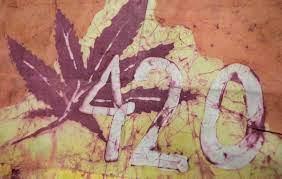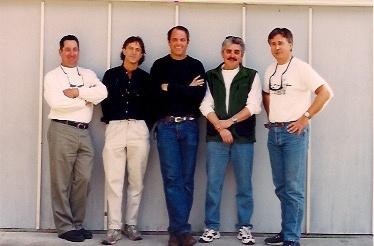
6 minute read
420 History - The Origin's of Cannabis' Biggest Day
It’s here again, everyone! Cannabis Christmas is here! April 20th, a.k.a 420, crept up on us again, and we couldn’t be more excited. 420 is the #1 holiday for any cannabis consumer, even if you don’t have party plans. The dispensaries are bound to have some good deals on everything from flower to rolling papers to topical creams. So many people know of and celebrate 420, but not many know its origins. Let’s get into it!
420, for as long as I can remember, was just a jokey term to reference cannabis. People used to write in on their lockers in high school to show they were cool, but now as cannabis has become more and more legal across the country, that’s probably less common.
One of the more recognized, and kind of silly, moments in 420 history takes place in 2009, according to History, the officials at the University of Colorado at Boulder and the University of California at Santa Cruz, “attempted to push back on the growing popularity of the festivities among their students.” These schools were practically on their knees begging for the students to at least chill out a little on the celebration but, just like any kids, their dislike of the holiday only made it more fun to celebrate. It’s extremely likely that more schools have had the same issues with their students' pursuits and 420. In fact, if the pandemic wasn’t going on in 2020, the entire month of April may have been celebrated by college students.
Some say that the reason people use 420 in reference to cannabis is due to a 2003 bill in California called SB420 when the California Legislature codified the medical marijuana law. Allegedly, this number was just a coincidence, but most people think it was on purpose. Nobody has confessed to doing it, however, it was likely a member of California State Assembly Member Mark Leno’s office.
The most assumed correct story on the origins of 420 dates all the way back to California in 1971. At San Rafael High School with a group of five teenage boys, Steve Capper, Dave Reddix, Jeffrey Noel, Larry Schwartz, and Mark Gravich, who called themselves the “Waldos”. According to History, “the Waldos learned of a Coast Guard member who had planted a cannabis plant and could no longer tend to the crop. Provided with a treasure map (some say by the plant’s owner himself) supposedly leading to the abandoned product, the group would meet at the Louis Pasteur statue outside their high school at least once a week to conduct a search. Their meeting time? 4:20 p.m, after each of their respective sports practices. The Waldos would pile into a car, smoke some pot and scour the nearby Point Reyes Forest for the elusive, free herb.” The group never did find the hidden cannabis treasure, but they did begin the code of 420 that would sweep the school and the nation. or all we know, the cannabis treasure is still out there.

Even if this was the origin, how is it possible for a couple high schoolers to influence the nation like this? We can attribute this to the one and only, Grateful Dead. Yep, the real band! One of the Waldos’ fathers, Gravich, worked with and actually managed the Dead’s real estate. Another’s older brother, Reddix, was good friends with Grateful Dead bassist Phil Lesh. Due to these connections, they all were able to hang out backstage at a place called Winterland and, of course, they were always using the term they had invented. It wasn’t long until 420 had spread through not only the band, but all the “Deadheads” (the playful name for fans of the Grateful Dead) as well.
After the 420 craze had become common among the Deadheads, a reporter for High Times, Steven Bloom, heard the phrase for the first time during “Christmas week at a Grateful Dead concert in Oakland, California, in 1990. Bloom was wandering through the congregation of hippies that would gather before Dead concerts, and one of them handed him a flier that said, “We are going to meet at 4:20 on 4/20 for 420-ing in Marin County at the Bolinas Ridge sunset spot on Mt. Tamalpais.” Bloom found the old flier and sent it to Huffington Post as proof. The flier told the history of 420, referencing the Waldos of San Rafael. Once “High Times” latched on to the story, the magazine helped launch the word globally,” reported History.
The group even has the most legitimate proof that they are the true origins of 420. “Kept safely tucked away in a vault in a San Francisco bank is their original 420 tie-dyed flag, a newspaper clipping where one of the members discusses wanting to just say “420” for his high school graduation speech and postmarked letters between the group filled with 420 references.” The Waldos should be one of the more well known groups in the cannabis world. The real group are grown up now, and some of them are considering making a documentary about their history with 420. No idea if it will come to fruition, but just knowing most of them are still in touch is amazing.
Unfortunately, they just aren’t well known in cannabis culture. There is a strain named Waldo bred in the Netherlands by Apothecary Genetics, so it’s probably not named after the Waldos. The Waldo cannabis strain, according to Leafly, “tends to be a Sativa dominant hybrid. The long-lasting high is generally more cerebral, with enough Indica kick to ease tension. These energetic effects may not make Waldo a good choice for night time or those treating anxiety.” It’s a great choice for social gatherings too!
Ultimately, this 420 we should recognize the impact of the Waldos. Without them, the number code for cannabis could have been way less cool. If you’re going to be celebrating 420 this year, take an edible or light up a joint for the Waldos. A group of super cool 70s high schoolers who had no idea they would lead to one of the most celebrated cannabis holidays in the world.









